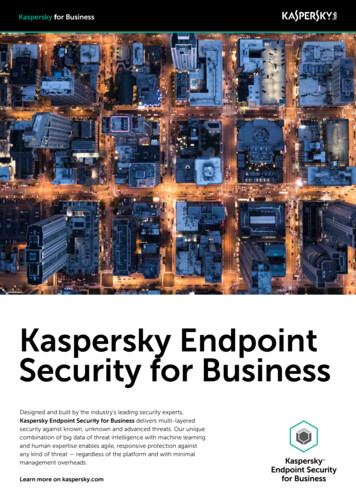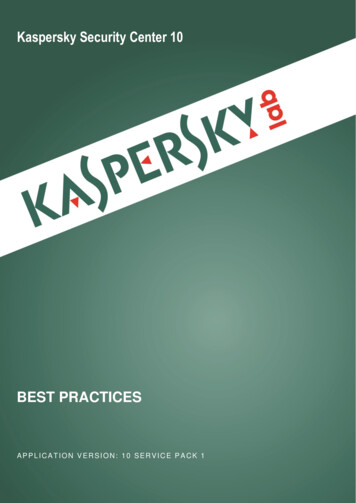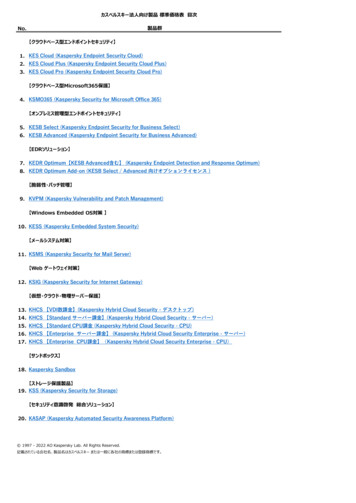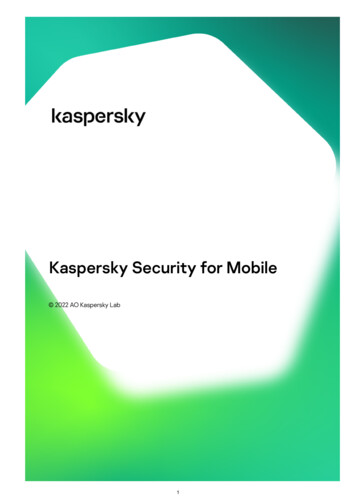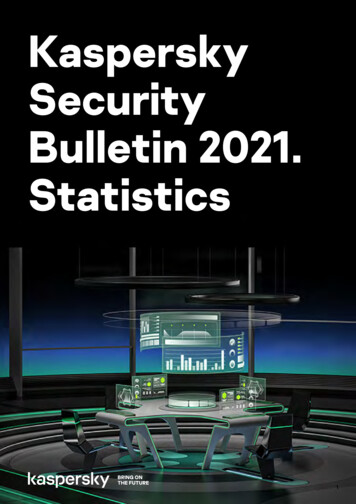
Transcription
KasperskySecurityBulletin 2021.Statistics1
ContentsFigures of the year 3Financial threats 4Number of users attacked by banking malware 4Top 10 financial malware families 4Attack geography 5Ransomware programs 6Number of users attacked by ransomware Trojans 6Attack geography 7Miners 9Number of users attacked by miners 9Attack geography 9Vulnerable applications used by cybercriminals during cyberattacks 10Attacks on macOS 12Threat geography 12IoT attacks IoT threat statistics Attacks via web resources 141415Countries that serve as sources of web-based attacks 15Countries where users faced the greatest risk of online infection 16Top 20 malicious programs most actively used in online attacks 18Local threats Countries where users faced the highest risk of local infection 19202
Figures of the year During the year, 15.45% of internet user computers worldwide experienced at least one Malware-class attack. Kaspersky solutions blocked 687,861,449 attacks launched from online resources across the globe. 114,525,734 unique malicious URLs triggered Web Anti-Virus components. Our Web Anti-Virus blocked 64,559,357 unique malicious objects. Ransomware attacks were defeated on the computers of 366,256 unique users. During the reporting period, miners attacked 1,184,986 unique users. Attempted infections by malware designed to steal money via online access to bank accounts were logged on thedevices of 429,354 users.All statistics in this report are from the global cloud service Kaspersky Security Network (KSN), which receives informationfrom components in our security solutions. The data was obtained from users who had given their consent to it beingsent to KSN. Millions of Kaspersky users around the globe assist us in collecting information about malicious activity.The statistics in this report cover the period from November 2020 to October 2021, inclusive.3
Financial threatsThe statistics include not only banking threats, but also malware for ATMs and payment terminals. Statistics on analogousmobile threats are given in the separate report.Number of users attacked by banking malwareDuring the reporting period, Kaspersky solutions blocked attempts to launch one or more malicious programs designed tosteal money from bank accounts on the computers of 429,354 users.Number of users attacked by financial malware,November 2020 — October 2021Top 10 financial malware jan.Win32.Neurevt1.7Unique users attacked by this malware as a percentage of all users attacked by financial malware.4
Attack geographyTo evaluate and compare the risk of being infected by banking Trojans and ATM/POS malware worldwide, for each countrywe calculated the share of users of Kaspersky products who faced the financial threat during the reporting period as apercentage of all users of our products in that country who were attacked.Geography of banking malware attacks,November 2020 — October 2021Top 10 countries by share of attacked ta Rica2.78Sudan2.49Kazakhstan2.210Syria2.2* Excluded are countries with relatively few Kaspersky product users (under 10,000).** Unique users whose computers were targeted by financial malware as a percentage of all users attacked by all kinds of malware.5
Ransomware programsDuring the reporting period, we identified more than 13,905 ransomware modifications and detected 33 new families. Notethat we did not create a separate family for each new piece of ransomware. Most threats of this type were assigned thegeneric verdict, which we give to new and unknown samples.Number of new ransomware modifications detected,November 2020 — October 2021Number of users attacked by ransomware TrojansDuring the reporting period, ransomware Trojans attacked 366,256 unique users, including 92,863 corporate users (excludingSMBs) and 12,699 users associated with small and medium-sized businesses.Number of users attacked by ransomware Trojans,November 2020 — October 20216
Attack geographyGeography of attacks by ransomware Trojans,November 2020 — October 2021Top 10 countries attacked by ransomware istan1.038China1.019Ethiopia1.0010Pakistan0.87* Excluded are countries with relatively few Kaspersky users (under 50,000).** Unique users whose computers were attacked by Trojan encryptors as a percentage of all unique users of Kaspersky products in the country.7
Top 10 most common families of ransomware generic verdict)Trojan-Ransom.Win32.Gen9.734(generic verdict)Trojan-Ransom.Win32.Crypren9.315(generic verdict)Trojan-Ransom.Win32.Encoder6.666(generic verdict)Trojan-Ransom.Win32.Phny6.227(generic lyRansom2.729(generic verdict)Trojan-Ransom.Win32.Generic1.5710(generic verdict)Trojan-Ransom.Win32.Crypmod1.40* Kaspersky users attacked by a particular family of ransomware Trojans as a percentage of all users attacked by ransomware Trojans.8
MinersNumber of users attacked by minersDuring the reporting period, we detected attempts to install a miner on the computers of 1,184,986 unique users. Minersaccounted for 2.19% of all attacks and 16.88% of all Risktool-type programs.Number of users attacked by miners,November 2020 — October 2021During the reporting period, Kaspersky products detected Trojan.Win32.Miner.bbb more often than others, accounting for20.73% of all users attacked by miners. It was followed by Trojan.Win32.Miner.gen (11.58%), Trojan.Win32.Miner.ays (8.73%)and Trojan.Win32.Miner.vogh (3.52%).Attack geographyGeography of miner-related attacks,November 2020 — October 20219
Vulnerable applications used by cybercriminalsduring cyberattacksNotably, most of the reporting period's zero-day vulnerabilities were detected during active exploitation by cybercriminals,including well-known APT groups. Throughout 2021, Kaspersky experts discovered several vulnerabilities, including: The vulnerability CVE-2021-28310, which we believe was exploited by the BITTER APT group. An out-of-bounds (OOB)write bug in Desktop Window Manager allows data to be written outside the memory buffer, enabling privilege escalationin the system. This allows attackers, for example, to break out of the sandbox if this vulnerability is exploited with someother vulnerability in the browser or other software. We have already detailed this CVE in a separate report. Two vulnerabilities (CVE-2021-31955, CVE-2021-31956) used in a chain of exploits as the second stage afterexploitation of a vulnerability in the browser to break out of its sandbox. The first of these two vulnerabilities is aninformation leak, allowing an attacker to obtain the address of the EPROCESS structure in the kernel memory; thesecond uses a heap memory overflow bug in the NTFS driver to read and write arbitrary data in the kernel memory, whichin turn can lead to privilege escalation in the system. A detailed technical description of both can be found in our post. CVE-2021-40449, used by an APT group in the MysterySnail operation, is a use-after-free vulnerability in the win32kdriver. It reveals itself during the processing of user callback functions and ultimately delivers control over the attackedsystem. See here for our technical analysis of this vulnerability.Our partners detected other attacks that exploited various vulnerabilities: Fourteen vulnerabilities in Google Chrome (CVE-2021-21148, CVE-2021-21166, CVE-2021-21193, CVE-2021-21206,CVE-2021-30551, CVE-2021-30554, CVE-2021-30563, CVE-2021-30632, CVE-2021-30633, CVE-2021-37973,CVE-2021-37975, CVE-2021-37976, CVE-2021-38000, CVE-2021-38003) were used by various cybercriminalsto compromise attacked systems and run malicious code. Most of the vulnerabilities affected the V8 scripting engineand exploited bugs related to heap buffer overflow, race conditions and data type confusion, as well as use-after-freevulnerabilities in Blink, Audio and other components. Four remote code execution vulnerabilities were discovered in Microsoft Exchange Server (CVE-2021-26855,CVE-2021-26857, CVE-2021-26858, CVE-2021-27065). They allow attackers to gain control of mail servers that havenot been duly patched. Four remote code execution vulnerabilities in Microsoft Internet Explorer (CVE-2021-26411, CVE-2021-33742,CVE-2021-34448, CVE-2021-40444) can be used to introduce malware into the target system through infectedwebsites visited by the user. Two vulnerabilities (CVE-2021-21017, CVE-2021-28550) exploiting heap overflow and use-after-free bugs in AdobeReader. Five vulnerabilities in the Microsoft Windows operating system itself (CVE-2021-31199, CVE-2021-31201,CVE-2021-33771, CVE-2021-31979, CVE-2021-36948) and one in Microsoft Windows Defender (CVE-2021-1647).These also allow an attacker to elevate system privileges.10
In the reporting period, we saw a downward trend in the number of exploitations of Microsoft Office vulnerabilities (-17.25 p.p.),although exploits for this software suite are still the most popular among cybercriminals, being the easiest way tocompromise vulnerable user systems. Among the most frequently used CVEs are CVE-2017-11882, CVE-2018-0802,CVE-2017-8570 and CVE-2017-0199, which we have covered many times in previous posts. Also at the end of this yearwe have observed the newly discovered vulnerability CVE-2021-40444, active in the MSHTML engine of Internet Explorerand often exploited through a specially prepared Microsoft Office document with an embedded malicious ActiveX controlfor executing arbitrary code in the system. The emergence of public exploits for this vulnerability has spurred attempts totake advantage of it. See our article for details of CVE-2021-40444 exploitation.Browser vulnerabilities are in second place in terms of popularity; in 2021 they were patched in succession by out-of-bandsecurity updates, while showing growth of 16.41 p.p. against the previous reporting period.Third place in our statistics belongs to the Android platform, which lost 2.35 p.p. in the reporting period; the now obsoleteAdobe Flash platform ( 2.2 p.p.) lies in fourth place; Java is in fifth, while last place goes to vulnerabilities in PDF documents( 1.09 p.p.).The rating of vulnerable applications is based on verdictsby Kaspersky products for blocked exploits used bycybercriminals both in network attacks and in vulnerablelocal apps, including on users' mobile devices.The reporting period did not see any major changes tothe statistics on exploitation of vulnerabilities in networkservices and components; bugs in software and OScomponents are still a common method to penetratevulnerable systems. However, most of the new exploitsin 2021 were published by researchers, not found in-thewild during exploitation by attackers. For example, criticalvulnerabilities were discovered in Windows server anduser systems, and were widely publicized in the mediaunder the names PrintNightmare, HiveNightmare/SeriousSAM and PetitPotam. Other headline finds includea string of exploits for Microsoft Exchange Servervulnerabilities (ProxyToken, ProxyLogon, ProxyShell).Lastly, we continued to detect brute-force attacks onvarious network services, in particular RDP, MS SQL andSMB. Exploits from the Equation Group for outdatedand unpatched Microsoft Windows systems also remainpopular, among which EternalBlue and EternalRomancestand out from the crowd.Distribution of exploits used in attacksby type of application attacked,November 2020 — November 202111
Attacks on macOSAmong the most interesting finds during the reporting period were malware for Apple's MacBook with M1 processor, thenew Convuster adware for macOS written in Rust, as well as new samples of the XCSSET Trojan, which infects projects in theXcode development environment and steals data from browsers and other applications.Top 10 threats for r.OSX.Agent.h6.3810AdWare.OSX.Bnodlero.t6.27* Unique users who encountered this malware as a percentage of all users of Kaspersky security solutions for macOS who were attacked.Most of this reporting period's Top 10 was made up of adware. The Shlayer Trojan, which we wrote about back in early 2020,having ranked first in the last reporting period, dropped to fourth position.Threat geographyGeography of threats for macOS,November 2020 — October 202112
Top 10 countries by share of attacked .199United States5.9110Mexico5.60* Excluded from the rating are countries with relatively few users of Kaspersky security solutions for macOS (under 5000).** Unique users attacked as a percentage of all users of Kaspersky security solutions for macOS in the country.13
IoT attacksIoT threat statisticsDuring the reporting period, 77.47% of attacks on Kaspersky traps were carried out using the Telnet protocol.TelnetSSH77.47%22.53%Distribution of attacked services by number of unique IP addresses of devices that carried out attacks,November 2020 — October 2021As for distribution of sessions, Telnet also prevailed, accounting for more than two-thirds of all working sessions.TelnetSSH71.33%28.67%Distribution of cybercriminal working sessions with Kaspersky traps,November 2020 — October 2021Top 10 countries by location of devices from which attacks were carried out on Kaspersky Telnet traps*Country*%**1China42.192India14.203United n, Province of China2.028Egypt1.969Iran1.9210South Korea1.47Devices from which attacks were carried out in the given country as a percentage of the total number of devices in that country.Threats loaded into oader.Shell.Agent.bc1.36Share of malware type in the total number of malicious programs downloaded to IoT devices following a successful attack.14
Attacks via web resourcesThe statistics in this section are based on Web Anti-Virus, which protects users when malicious objects are downloadedfrom malicious/infected web pages. Cybercriminals create malicious websites on purpose; web resources with usercreated content (for example, forums), as well as hacked legitimate resources, can be infected.Countries that serve as sources of web-based attacksThe following statistics show the distribution by country of the sources of Internet attacks blocked by Kasperskyproducts on user computers (web pages with redirects to exploits, sites containing exploits and other malicious programs,botnet C&C centers, etc.). Any unique host could be the source of one or more web-based attacks.To determine the geographical source of web-based attacks, domain names are matched against their actual domain IPaddresses, and then the geographical location of a specific IP address (GEOIP) is established.In the reporting period, Kaspersky solutions blocked 687,861,449 attacks launched from online resources across the globe.Moreover, 89.9% of these resources were located in just 10 countries.Distribution of web attack sources by country,November 2020 — October 2021The Czech Republic (30.87%) took first place in the reporting period. After topping the leaderboard last year, the US(24.94%) moved down to second position. Germany took bronze (9.39%).15
Countries where users faced the greatest risk of online infectionTo assess the risk of online infection faced by users in different countries, for each country we calculated the percentageof Kaspersky users on whose computers Web Anti-Virus was triggered during the quarter. The resulting data provides anindication of the aggressiveness of the environment in which computers operate in different countries.This rating only includes attacks by malicious objects that fall under the Malware class; it does not include Web AntiVirus triggers in response to potentially dangerous or unwanted programs, such as RiskTool or adware. Overall, during thereporting period, adware and its components were registered on 78% of users' computers on which the Web Anti-Viruswas triggered.Top 20 countries where users faced the greatest risk of online tine18.0815Serbia17.9916Greece17.7317Saudi Arabia17.5718France17.5119Nepal17.4120Sri Lanka17.30* Excluded are countries with relatively few Kaspersky users (under 50,000).** Unique users targeted by Malware-class attacks as a percentage of all unique users of Kaspersky products in the country.16
On average, 15.45% of internet user computers worldwide experienced at least one Malware-class attack during thereporting period.Geography of malicious web-based attacks,November 2020 — October 202117
Top 20 malicious programs most actively used in online attacksDuring the reporting period, Kaspersky's Web Anti-Virus detected 64,559,357 unique malicious objects (scripts, exploits,executable files, etc.), as well as 114,525,734 unique malicious URLs on which Web Anti-Virus was triggered. Based on thecollected data, we identified the 20 most actively used malicious programs in online attacks on user computers.In the reporting period, the share of adware and its components accounted for 91% of the total number of triggerings ofour Web Anti-Virus on user computers.Verdict*%**1Malicious Script.Agent.gen0.14* Excluded from the list are HackTool-type threats.** Attacks by the given malicious program as a percentage of all Malware-class web attacks registered on the computers of unique users of Kasperskyproducts.18
Local threatsStatistics on local infections of user computers is an important indicator. They include objects that penetrated the targetcomputer through infecting files or removable media, or initially made their way onto the computer in non-open form (forexample, programs in complex installers, encrypted files, etc.). These statistics additionally include objects detected on usercomputers after the first system scan by Kaspersky's Anti-Virus application.This section analyzes statistics produced by Anti-Virus scans of files on the hard drive at the moment they were created oraccessed, as well as the results of scanning removable storage media.Top 20 malicious objects detected on user computersWe identified the 20 most commonly detected threats on user computers during the reporting period. Not included areRiskware-type programs and .GenBadur.gen1.2920Trojan.Win32.Agentb.bqyr1.28* Excluded from the list are HackTool-type threats.** The share of unique users on whose computers File Anti-Virus detected the given object in the total number of unique users of Kaspersky productswhose Anti-Virus was triggered by malware.19
Countries where users faced the highest risk of local infectionFor each country, we calculated how often users there encountered a File Anti-Virus triggering during the year. Includedare detections of objects found on user computers or removable media connected to them (flash drives, camera/phonememory cards, external hard drives). These statistics reflect the level of personal computer infection in different countries.Top 20 countries by level of risk of local tan50.0718Benin49.4819Libya49.1620Vietnam49.04* Excluded are countries with relatively few Kaspersky product users (under 50,000).** Unique users on whose computers Malware-class local threats were blocked, as a percentage of all unique users of Kaspersky products in thecountry.20
Geography of local infections by malware,November 2020 — October 2021During the reporting period, on average, at least one piece of malware was detected on 29.15% of computers, hard drivesor removable media belonging to users of Kaspersky solutions.
To evaluate and compare the risk of being infected by banking Trojans and ATM/POS malware worldwide, for each country . Four remote code execution vulnerabilities were discovered in Microsoft Exchange Server (CVE-2021-26855, CVE-2021-26857, CVE-2021-26858, . These also allow an attacker to elevate system privileges. 10.
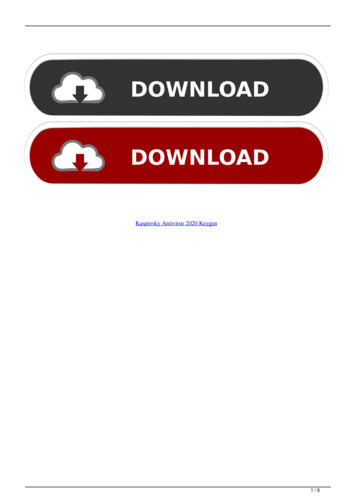
![Kaspersky Antivirus 6.0.4.1424. Key File 18 [REPACK]](/img/59/maramon.jpg)



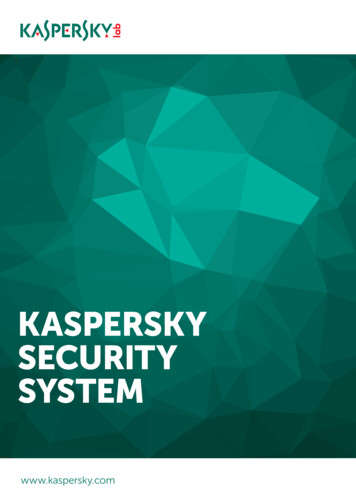
![Kaspersky Password Manager 9.0.1.447 Crack [BETTER]](/img/55/kaspersky-password-manager-901447-crack-better.jpg)
